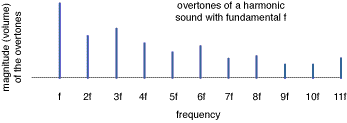

About TimbreThe timbre of a sound is its quality or character. There are two sides to timbre: time and frequency. Temporal (time-based) aspects include the envelope of the sound (the way it rises and falls over time) and time scale (the rate at which it evolves). Spectral (frequency-based) aspects include the number and location of the overtones and the presence of wideband noises.In the TransFormSynth, the temporal apsects of timbre are controlled primarily by the choice of sample and by the settings of the sliders in the main synth window. The spectral aspects are controlled in coordination with the tuning of the notes in the windows devoted to the various tuning continua. A note with fundamental frequency equal to f Hz is shown in blue in the figure below: besides the fundamental, it has energy at twice the fundamental, three times the fundamental, four times the fundamental, etc. Real notes often have dozens of such overtones. Notes like this are said to have harmonic overtones, or to have a harmonic spectrum, or even to "be" harmonic. 
Via a process called spectral mapping, the TransFormSynth is able to move the overtones of a sound to any desired location. |
©2008 William Sethares; site design by Anthony Prechtl |